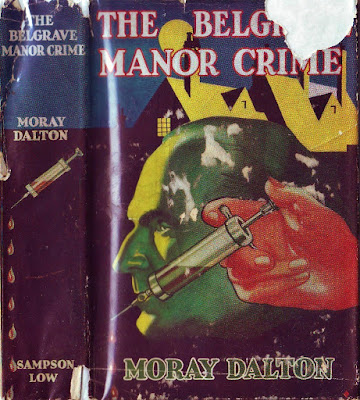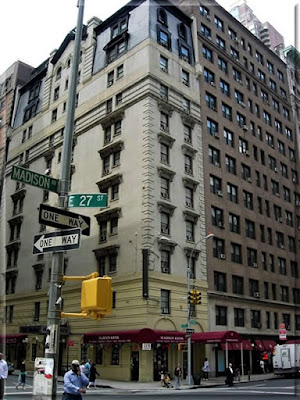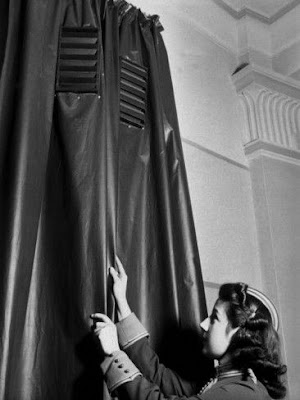For part one of Henry's saga see
here.
The headline was horrific. "
Wife, Beaten for 6 Years, Can't Take It Anymore," blared the title to the story about Aline (Stumer) von Rhau's divorce suit against her husband, author Henry von Rhau, in the
New York Daily News on April 27, 1933.
Before a Bridgeport, Connecticut courtroom packed with "
society folk," the
Daily News reported, "
the wealthy and socially prominent Aline Stumer von Rhau" testified before Superior Court judge Arthur F. Ells that the "
six years of her married life were marked by one long series of beatings, featured by an occasion when her husband devoted an hour and a half to punching and kicking her." The "
stunning brunette" and "
attractive brunette society woman" pleaded for a divorce from her "
tall, dashing husband, Major Henry von Rhau, United States Army, retired, now a novelist and actor," on the grounds of intolerable cruelty.
Once the story got into the nasty nuts and bolts of the case, things did not seem to get any better for Henry's cause. Testifying in support of Aline were friends Mary Messmore, daughter of famed New York society art dealer
Carman H. Messmore, and Katherine Fiske, daughter of the late
Haley Fiske, president of the
Metropolitan Life Insurance Company. Miss Messmore told of being on a visit to the couple's summer estate at Fairfield, Connecticut when she saw the Major stride into the house, elegantly clad in his riding habit, and kick Aline.
 |
it was testified that Henry had beaten Aline
over a game of backgammon
(pictured: Gracie Allen and George Burns) |
Henry was just as unpleasant to Aline when in the City, according to the testimony of Miss Fiske, which was was briefly quoted in the
Daily News. "
I was sitting with Mrs. von Rhau in her apartment at 955 Park Avenue one afternoon playing backgammon when Major von Rhau came in," she related. "
'Haven't you two got anything to do but play backgammon all the time?' he demanded." Thereupon, she claimed, von Rhau punched Aline in the jaw and ordered her, Miss Fiske, out of the apartment.
Another newspaper account, in the
Scranton Times Tribune, rather less formally quotes Miss Fiske's testimony on this point as follows:
"He cried: 'You lousy so-and-so, haven't you two got anything to do but play backgammon all afternoon? And he punched her on the jaw and said to get out of there."
Details of the worst episode in the von Rhau's married life together came directly from Aline herself. She contended that Henry had conspired with one of his friends, Thomas McHugh, to frame her for infidelity, giving von Rhau an excuse for administering to her the worst beating that she ever received from his hands. According to Aline, on the night in question she had been on her way to have dinner with her GBF Claude Kendall, publisher of the first book written by her husband (and the two novels of Kendall's and von Rhau's friend Willoughby Sharp), when she received a phone call from McHugh inviting them to have cocktails at his apartment before dinner.
 |
fighting continued after cocktails
(pictured Clark Gable and Constance Bennett) |
At McHugh's place it was not long before Claude Kendall, who by the time likely was suffering from increasing alcohol addiction, had passed out from imbibing too many cocktails, leaving Aline alone with McHugh, who, she said, suddenly got up and left the room. No sooner had he left than von Rhau entered the room and locked the door, announcing fiercely to Aline, "
Now, I am going to kill you." Stripping to his waist, he proceeded, in Aline's words, "
to beat me with his fists and [knock] me around the room for an hour and a half, ripping my clothes." When McHugh finally returned to the room, leaving the door open behind him, Aline fled for her life, out of the building and into a taxi. She spent the next month recovering in bed.
To top off this tale of wanton masculine viciousness, Aline added that during their marriage she had essentially "kept" her spouse, supplying Henry with four saddle horses, a valet and a car, paying all the household expenses and advancing him money so he could continue writing. "
He could never find a publisher," one newspaper noted, "
so finally she organized her own firm and put one of his novels on the market, but she lost money on it." (Was this Inwood Press, which originally published Henry's satire
The Hell of Loneliness? Did Aline get a friend, American expat John Mullins, to help finance von Rhau's
Tale of the Nineties?)
Additionally (and rather humiliatingly), Aline had even born the cost of her three-week honeymoon trip to Bermuda with Henry, even to the extent of picking up the tab for the travel fare of the freeloading Thornton Wallace "Wally" Orr, "
Manhattan clubman and crony of the Major's, who made the voyage with them." According to Aline, her new husband actually had spent most of the honeymoon not in her company, but that of Wally Orr, who, it will be recalled, had been best man at their wedding.
 |
Aline found three a crowd on her honeymoon in Bermuda,
when Henry's best man tagged along |
Of course the defense did not allow Aline's parade of horribles to go unchallenged. Henry's attorney demanded of Aline to know why she had married von Rhau when she knew that he was a man of "
nervous and irritable" temper, to which Aline invoked the power of a woman's true love, replying, "
I thought if I married him and gave him a good home, which he had never had, it would cure him."
Additionally, several former army associated and friends of von Rhau's took the stand in his defense, making the case very much of a "boys versus girls" affair. (The newspapers did not quote the men, however, so I do not know whether such pals of Henry's as Willoughby Sharp, Jack Boissevain and famed playwright and Henry's GBF
John Colton took the stand.)
For his part, Henry emphatically denied that he had ever beaten Aline. One newspaper reported that the former bit part actor "
presented a picture of abject humility on the stand." He called himself "
the world's worst husband," explaining that he was "
temperamental because I'm a literary man, selfish and thoughtless." Yet he insisted that although "
my shortcomings as a husband were of the gravest kind,,,,I love her, and I never beat her."
Henry admitted to only one physical misdeed with Aline, which took place, he said, at a dinner party they had given, where Aline had twice abandoned their guests to go for a car ride with the same male guest. "
On the second occurrence I slapped her. I'm sorry I did." On another occasion Henry admitted to using force with Aline, but in that instance it was done "
to keep her from jumping out a window." Von Rhau insisted that he wished to reconcile with Aline, in part for the sake of their four-year-old son, Anthony, but also because he still loved her. Aline remained "
the loveliest girl I have met," he declared on the stand, bringing tear's to his wife's eyes.
Impressed with von Rhau's testimony that "
his one idea in life was to become reconciled with his wife," Judge Ells "
summoned the couple to his chambers, excluding even lawyers, and sought to bring them together." This attempt was unsuccessful, however, with Aline emerging after thirty minutes with Henry in the judge's chambers still resolved upon obtaining a divorce. Such was granted a week later, Judge Ells having determined that "
intolerable cruelty was proved by a fair preponderance of the evidence." Yet Judge Ells, in a pregnantly suggestive comment, also made a point of commending von Rhau's "
chivalry during the trial." Had "dirt" about Aline been left out of the courtroom?
Perhaps Judge Ells heart was gladdened when, just a few weeks after he granted the divorce, Aline and Henry remarried. The next year Aline gave birth to the couple's second child, a daughter named Cynthia, on November 28. A month later the von Rhau hosted a Christmas Eve "
cocktail party for intimate friends." Over the next two years, newspaper society pages were full of accounts of the whirl of activities engaged in by the seemingly happily reunited Mr. and Mrs. van Rhau. In February 1935, the couple departed on an eighteen day cruise to South America. The next year the von Rhaus left New York for Los Angeles, perhaps with the goal of introducing Henry to Hollywood. Their doings were frequently detailed in newspaper society pages.
 |
| Soubrette, by Alexander Mann |
In LA the couple was frequently accompanied by Henry's playwright pal John Colton, in keeping with Henry's habit of having a stag male friend tag along with him and Aline.
In June Henry and Aline attended a buffet supper dance in costume. Henry was decked out as a Prussian military officer--seemingly his favorite performative role--while Aline, recalling Henry's bawdy book
Tale of the Nineties, came dressed as an 1890s burlesque soubrette. (One imagines the couple enjoyed a lively fantasy life.) John Colton was present as well, though sadly no information was provided about the costume he wore.
Aline and Henry made news as well when they appeared separately. In August Aline attended a "
Bavarian party" (questionable taste, perhaps, in 1936), where famed soprano
Rosa Ponselle "
sang Strauss waltzes divinely," and attended a performance of John Colton's new stage comedy,
She Tripped up the Queen. In September Henry along with John Colton attended a dinner party given by screenwriter and composer Sam Hoffenstein and his wife Edith in honor of Chester Alan Arthur III (aka Gavin Arthur), grandson of the American president of the same name and a future pioneering gay rights activist. Other guests included author
Anita Loos and her husband, director
John Emerson; actor
Fredric March and his wife, actress
Florence Eldridge; and pianist
Alex Steinert, who during the "
wee small hours" played the entire score of
Gershwin's Porgy and Bess, along with his own arrangements of pieces by the Russian composers
Rimsky-Korsakoff and
Borodin.
 |
dude ranching in the Thirties
(not Henry and Aline) |
It was for relaxation from this hectic social whirl that Aline and Henry, with John Colton in tow, went to a California dude ranch, the Rancho Verde, in October, a chatty
LA Times society column informed its readers:
While "Hank" was busily learning to become a cowpuncher by chasing...steers around and around, John relaxed on the front porch of his cottage with his feet in the sun and head in the shade and a flit gun in his hand. Oh, for a camera!
Aline got aboard a horse for the first time in ten years and isn't sitting down with any comfort yet. And it all comes under the head of fun--which as a matter of fact it really is.
But the fun was over by December, when, five days after Christmas, Aline again filed for a divorce from Henry, accusing her husband for a second time of intolerable cruelty and asking for custody of their two children, eight-year-old Anthony and two-year-old Cynthia.
This time no details of the divorce suit were published in the newspapers, but Aline's suit had been granted seven weeks later, in February 1937, when French Riviera habitue John Edward Mullins, who it will be recalled had underwritten (At Aline's behest?) Henry's book
Tale of the Nineties, was divorced at Grasse by his wife, Silvia Marietta Jose, on grounds of desertion. Immediately after the divorce, Mullins announced his engagement to Aline Stumer, formerly von Rhau. Mullins planned to depart from Marseilles aboard the steamship
Excalibur, his destination being Beverly Hills and Aline. In the event, however, Mullins wed not Aline, but one Gladys Celene Carroll, on April 26 in Manhattan. Two months later he died aboard the Italian ocean liner
Rex, the diagnosed cause being "
delirium tremens, with hepato-cardiac insufficiency" (meaning, I assume, that chronic long-term alcohol abuse on Mullins' part had led to fatal heart failure).
 |
| Riviera expats |
Sadly, the perils of Aline would continue over the next dozen years, much to the enjoyment of the newspapers, which liked nothing better--with the exception of murders of course--than lurid tales of erratic heiresses. In 1938, while residing in LA at 7959 Hollywood Boulevard, Aline was arrested with her twenty-two-year-old brother Louis on suspicion of drunk driving and embarrassingly booked at the county jail, where she gave her name as Mrs. Aline von Rhau--von Rhau, to be sure, having more aristocratic cachet than Stumer.
Meanwhile multiple-handled Aline's mother Blanche Regina (Griesheimer) Stumer Giddens did her part to keep the Stumer clan in unfavorable headlines. In 1938, having divorced her second husband, Blanche at age fifty-five married forty-six-year-old
Count Eugenio Casagrande, an Italian Great War hero, celebrated aviator and naturalized American citizen who not long after Pearl Harbor was detained as a dangerous enemy alien by FBI agents at an internment camp at Ellis Island.
Casagrande, "
a darling of the Park Avenue circles" who before his arrest had been general secretary of the
Unione Italiana di America, a federation of three hundred Italian and Italian-American societies, was characterized by the ever-informative
New York Daily News as "
an original Fascist." Blanche--or, as she was now known, Countess Casagrande--divorced the Count the next year. The Stumer women seem to have relinquished their own Jewish heritage, incidentally. Blanche, for example, altered her hefty surname Grieseheimer to Gresham, as did her daughters, and all three women seem to have had Christian weddings. Doubtless those Park Avenue circles that were so admiring of Eugenio Casagrande would not have had it any other way.
 |
| Eugenio Casagrande |
Although apparently politically anodyne, at least, Aline's matrimonial record in the Forties proved every bit as disastrous as her mother's, if not more so. Successively she wed and divorced three different men in under a decade, beginning in 1940 with Ernest Irving Rodehau, a salesman and son of German immigrants, continuing with Walter C. French in 1943 and concluding, most enticingly ingloriously, with Turkish native Orhan Lambiro in 1949.
From the last listed of the spouses, Aline sought a divorce after merely twelve days of marriage, bringing to mind the appellation "
Aline of a Dozen Days."
Although with her third and fourth marriages and divorces (after the two with Henry), Aline seems to have avoided adverse notice from the press, the third sequence simply had too many outre elements, by postwar American standards, to let pass unmentioned in the newspapers. At the time he wed forty-five-year-old Aline, Orhan Lambiro was but twenty-three, working as a lifeguard and "
beach boy" at Miami Beach. Initially newspapers reported that Lambiro was the son of Turkish diplomat, but the modest young lifeguard--described, predictably, as "
dark" and "
husky" by the newspapers--corrected the record.
Speaking to reporters Lambiro explained that he was not the son of the Turkish delegate to the United Nations, his father being merely an employee of the Turkish delegation. Aline, he claimed, had been responsible for the propagation of that falsehood: "
She didn't want her fourth husband--me--doing common work, so I suppose she didn't want my father to be a working man either." Lambiro added that he had been an American Army staff sergeant during the Second World War, serving overseas in Europe.
Aline had her own complaints, however, as she had years ago concerning Henry. Lambiro, she asserted, had pressured her to finance a Miami Beach bookie joint and additionally had, like Henry, beaten her. (Lambiro did have gambling offenses in an arrest record.) She demanded one hundred dollars in weekly alimony from Lambiro, who attested that as a lifeguard he made but fourteen dollars a week (about one hundred and fifty dollars today).
Lambiro countered with his own tale of woe, insisting that Aline had humiliated him by frequenting bars with another man. He also claimed she told him that she had married him "
solely for spite." He asked that the divorce petition be dismissed at Aline's cost. Certainly Aline's case was not helped when her attorney called off the alimony hearing upon learning that Aline had an income of seven hundred dollars a week--today about $7500 a week, or $360,000 a year. $360,000 may have seemed like penury to Aline, but it would not have seemed so to most people, and certainly not to Orhan Lambiro.
However it was all finally worked out, the unblissfully wedded couple successfully divorced the next year. Aline would marry one or two more times before she passed away at the age of seventy in 1975. But what of Henry van Rhau? He married again too. How did that marriage turn out? More soon, in the last part of the saga of "Baron" Henry and his wives.









































